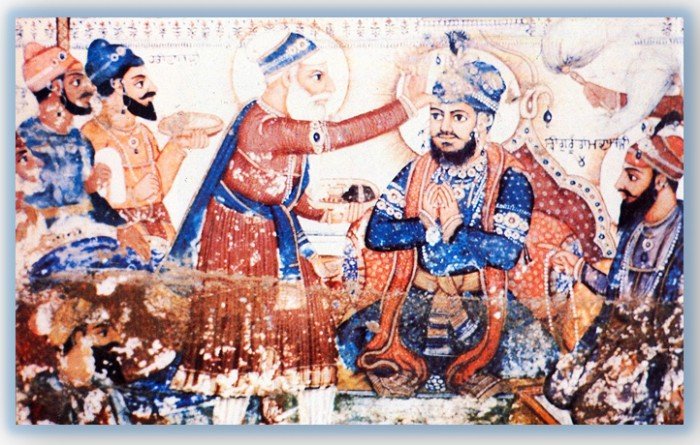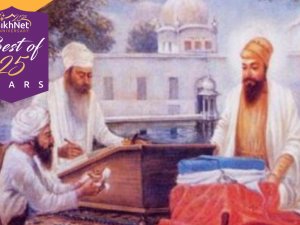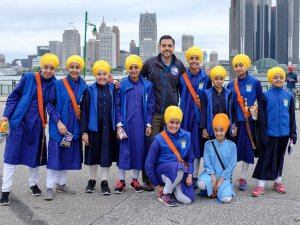 |
| Guru Ramdas ji bestowing Guruship to Guru Arjan Dev Ji |
Why the coming of Guru Ram Das Ji was pivotal to the Guruship
sodtee srist sakal thaaran ko ab gur raamadhaas ko milee baddaaee ||3||
Guru Raam Daas of the Sodhi dynasty has now been blessed with Glorious Greatness, to carry the whole world across. ||3||
(Sri Guru Granth Sahib Ji; Bhatt Bal: Ang 1406)
The birth of Guru Ram Das Ji; the fourth Guru of the Sikhs was a crucial point in changing the history of the Sodhi dynasty, which separated into two factions; the Sodhis and the Bedis. The birth of Guru Ram Das Ji would unite both factions of the Sodhi lineage together in the House of Guru Nanak Dev Ji.
As we delve closely into the family tree of the Sikh Gurus, we find from the second Guru onwards, all the Gurus were related. Guru Amar Das Ji's brother's nephew was married to the daughter of Guru Angad Dev Ji, Bibi Amro Ji, which therefore made both Gurus in-laws; Guru Ram Das Ji became the son-in-law of Guru Amar Das Ji after marrying Bibi Bhani Ji. The bloodline of Guru Ram Das Ji continued right through to the tenth and final physical Guru of the Sikhs, Guru Gobind Singh Ji (Sodhi Rai).
Many Sikh historians have debated that Guru Nanak Dev Ji rejected his own two sons (Baba Sri Chand and Baba Lakhmi Chand) when passing the Guruship over to Guru Angad Dev Ji, thus ending the bloodline of the Bedis. This is not entirely true, as the bloodline of Guru Nanak Dev Ji continued through to Guru Ram Das Ji.
Guru Nanak Dev Ji was born into the family of the Bedis, who were the descendants of Kush, the son of Rama and Guru Ram Das Ji was born into the family of the Sodhis, who were the descendants of Luv, the other son of Rama. The births of Guru Nanak Dev Ji and Guru Ram Das Ji were both prophesised thousands of years before, where they will bring the virtuous acts of righteousness and the Truth of Dharma in the Dark Age of Kaljug.
Guru Gobind Singh Ji methodically tells the tale of the Sodhi dynasty in his composition of Bachittar Natak (Wondrous Drama) within Sri Dasam Granth.
Many centuries and generations after the deaths of Luv and Kush, quarrels over the kingdom broke out between both descendants. They waged a great war against one another. The once greater of the two Sodhi Kings, the descendant of Kush, was banished from the Kingdom and Punjab by the descendants of Luv. With very little possessions and belongings, the descendants of Kush proceeded to Banaras in Ka(n)shi, the most spiritual and holiest capital of India. There they took on the robes of sages (Rishis) and learnt all the Vedic scriptures off by heart. Through their popularity and distinction, they became to be known as the Vedis (or Bedis), the great reciters of the Vedas.
jinai baedh pat(h)iou s baedhee kehaaeae || thinai dhharam kae karam neekae chalaaeae ||
Those who studied the Vedas were called Vedis (Bedis). They conducted their religious activities rightly.
pat(h)ae kaagadha(n) maadhr raajaa sudhhaara(n) || apo aap mo bair bhaava(n) bisaara(n) || 1||
The King of the Punjab (Sodhi now) sent a letter (to Bedis) to improve (bilateral relations), Requesting them to forget their mutual animosity between them. (1)
(Sri Dasam Granth; 123)
Generations later, the King of Punjab of the Sodhi dynasty learnt that he had family living in India and were exiled from Punjab many generations ago. He decided to write a letter to the Bedis, who were at this time residing in Ka(n)shi, inviting them to their ancient homeland to improve mutual relations and to forget any hostility between both families.
On receiving the letter, all the reciters of the Vedas (Bedis) proceeded to meet with the Sodhi King. On their arrival to Punjab, the Bedis were greeted with utmost respect and gratitude. As per Vedic tradition, the Sodhi King requested the Bedis to recite the four Vedas in the court. The Bedis agreed and began reciting the Vedas. All the offspring of Luv and Kush sat down together with the Bedis to listen to the recital of the Vedas. As they were about to begin the fourth and final Veda (Atharva), the Sodhi King became so overwhelmed by their recitation of the first three he fell at the feet of the Bedis. He declared they were the true Sodhis and bestowed the reign of the Kingdom to the Bedis. He sat the chief Bedi, Amrit Rai upon his throne and paid obeisance to the new King.
dhhuna(n) baedh kee bhoop thaa(n) karaaee || sabai paas bait(h)ae sabhaa beech bhaaee ||
The king made them recite the Vedas with cadence and tradition. All the brothers (offspring's of Luv and Kush) sat down together in a meeting.
parraeh saam baedha(n) jujar baedh kaathha(n) || riga(n) baedh pat(h)iya(n) karae bhaav haathha(n) || 3||
Bedis recited Sama Veda and delivered discourses on Yajur Veda. They read out the Rig Veda; (hearing which the host king) grasped the purport. (3)
(Sri Dasam Granth; 123)
Bedi Amrit Rai was so pleased with the Sodhi King's humility and generosity he granted him a boon. The boon was that in the Iron Age of Kaljug, a great being shall emerge from the Bedi clan, who will bring lightness to this world. In three successive bodies, he will take the birth as the fourth successor and emerge from the Sodhi clan. There he will continue the line of Sodhis throughout this Dark Age.
baedhee bheae prasa(n)n raaj keh paae kai || dhaeth bhayo baradhaan heeai hulasaae kai ||
Bedi chief was very pleased to have obtained the kingdom; And rejoiced at heart, he granted (or predicted Sodhis) the following boon:
jab naanak kal mai ham aan kehaaeihai(n) || ho jagath pooj kar thohi param padh paaeihai(n) ||7||
"When in the Iron age, I shall be called Nanak. I shall designate you as the Guru, to be worshipped by the worldly people and I shall attain the Supreme position."(7)
(Sri Dasam Granth; 124)
theen janam hamehoo(n) jab dhharihai(n) || chouthhae janam guroo thuhi karihai(n) || 9||
When I shall have taken three births (as a Guru) or, (three successive bodies), I shall make you the Guru in the fourth birth (body)". (9)
(Sri Dasam Granth; 125)
Bestowing his wealth and kingdom, the Sodhi King and the descendants of Luv set off into the forests and adopted the garb of sages (Rishis) in pursuit of a more spiritual and secular life.
This prophecy came true on the 24th of September 1534. Guru Ram Das Ji was born into the family of Sodhis. In 1574, Guru Ram Das Ji became the fourth successive Light of Guru Nanak Dev Ji. The lineage of the Sodhis was established in the House of Guru Nanak Dev Ji.
jab baradhaan samai vahu aavaa || raamadhaas thab guroo kehaavaa ||
As the time approached for the boon, granted anciently to happen, Then Ram Das (of the Sodhi dynasty) was proclaimed as the (fourth) Guru (Le. the Spiritual Master).
thih baradhaan puraathan dheeaa || amaradhaas surapur mag leeaa || 8||
(The third Guru Amar Das Bhalla) bestowed the boon offered anciently (to Ram Das Sodhi) in the form of Guruship--seat of spiritual kingdom and made him the Guru. Guru Amar Das' soul mingled with the Supreme Soul. (8)
(Sri Dasam Granth; 126)
With Guru Nanak Dev Ji leading the path to the Truth and Dharma, the destinies of Lehna (Guru Angad Dev Ji), Amar Das Bhalla (Guru Amar Das Ji) and Jetha (Guru Ram Das Ji) were yet to be unveiled in times to come ahead. The birth of Guru Ram Das Ji was one of the most phenomenal and auspicious moments upon earth:
- The time of Guru Ram Das Ji's birth, Guru Nanak Dev Ji (65 years old)was residing in Kartarpur
- Guru Angad Dev Ji, who was Lehna at this time, was serving Guru Nanak Dev Ji
- The Light of Guru Nanak Dev Ji merges with Guru Angad Dev Ji; Guru Angad Dev Ji becomes the second Guru in 1538. Guru Ram Das Ji is 4 years old at this point
- Guru Nanak Dev Ji leaves his physical form in 1539. Guru Ram Das Ji is 5 years old
- Guru Ram Das Ji meets Guru Amar Das Ji in 1542 in Baserke at the age of seven
- Guru Ram Das Ji is 18 years old when Guru Amar Das Ji becomes the third Light of Guru Nanak Dev Ji in 1552
Guru Ram Das Ji became an orphan at the tender age of seven and lived in severe poverty. It was premeditated that Guru Ram Das Ji would lead his childhood stricken with poverty for this reflected the state of the Sodhi dynasty (the descendants of Kush and Guru Ram Das Ji), who bequeathed their entire kingdom and wealth to the Bedis. It would be meeting with Guru Amar Das Ji that Guru Ram Das Ji would be sat upon the throne of the spiritual kingdom and be made Guru. Guru Ram Das Ji would overcome his poverty and attain the True wealth of the Lord's Name, thus establishing the kingdom of the Sodhis once again in the House of Guru Nanak.
Harjinder Singh Khalsa





